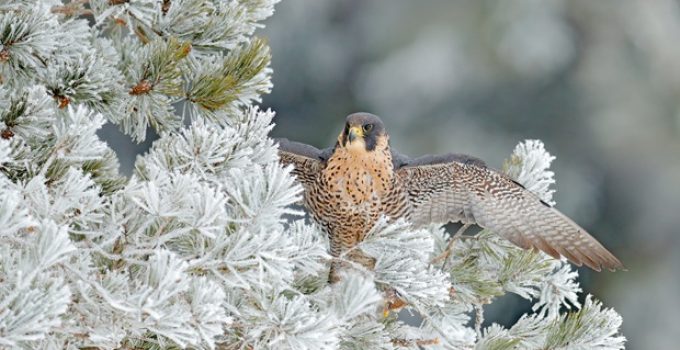Where Do Falcons Sleep?
Falcons sleep in elevated, sheltered locations that provide safety from predators and good visibility. Unlike some birds that nest communally or in tree hollows, falcons prefer solitary, open roosts such as cliffs, tall trees, and urban skyscrapers. Their sleeping behavior, known as roosting, varies depending on the species, habitat, and season.
Dive Deeper
- How Falcons Sleep
- Where Falcons Roost in the Wild
- Urban Falcons: Skyscraper Sleepers
- Do Falcons Sleep in Nests?
- Day vs. Night Roosting
- 🎯 Final Thoughts
- 📚 References
How Falcons Sleep
Falcons are diurnal, meaning they are active during the day and rest at night. When sleeping:
- They perch on a safe, elevated structure.
- They often tuck one leg up and turn their head backward, resting it on their back feathers.
- Like many birds, falcons exhibit unihemispheric slow-wave sleep, where one brain hemisphere stays alert while the other sleeps—a survival trait [1].
| 📌 Fun Fact: Falcons often sleep with one eye open—literally! This helps them remain vigilant to threats even while resting.
Where Falcons Roost in the Wild
Wild falcons seek out high and remote places to rest safely:
| Roosting Spot | Description |
|---|---|
| Cliff ledges | Classic choice for Peregrines; offers height and visibility |
| Rocky outcrops | Used by Gyrfalcons in Arctic regions |
| Dead tree snags | Especially common for American Kestrels |
| Large raptor nests | Some falcons reuse old hawk or eagle nests for perching |
Falcons rarely sleep on the ground, as this exposes them to predators and environmental stress.
Urban Falcons: Skyscraper Sleepers
Many falcons have adapted to human-dominated landscapes, especially Peregrine Falcons, which thrive in cities. In urban settings, their roosting spots include:
- Building ledges and rooftops
- Bridge understructures
- Cathedral spires
- Cell towers or utility poles
Cities offer artificial “cliffs,” consistent warmth, and abundant prey like pigeons. Urban falcons often become local celebrities, with webcams documenting their sleeping and nesting routines.
| 📊 According to a report from the Urban Peregrine Project, over 25 major cities in North America now have year-round urban roosting falcons [2].
Do Falcons Sleep in Nests?
Generally, falcons only use nests during the breeding season. These nests—called scrapes—are shallow depressions on ledges or in cavities where they lay eggs.
- Outside the breeding season, falcons do not sleep in nests.
- Males and females typically roost separately unless guarding eggs or chicks.
- Some species reuse the same roost site year after year, especially if it’s safe and high.
🌟 Unlike songbirds, falcons do not build nests out of twigs or grass. Most simply use bare rock or dirt as their nesting surface.
Day vs. Night Roosting
While falcons are daytime hunters, they may take brief daytime rests in shady, secure spots—especially after a big meal.
- Day roosts: Often shaded, low-activity locations where they digest or preen.
- Night roosts: High, safe perches used consistently to sleep and avoid predators.
Different roosts may be used depending on weather, food availability, or human disturbance.
| 🌳 The American Kestrel often roosts in cavities, including old woodpecker holes, during cold winters to retain body heat [3].
🎯 Final Thoughts
So, where do falcons sleep? High, solitary roosts such as cliffs, trees, or urban ledges serve as their preferred sleeping spots. These sites provide security, visibility, and quick access to flight. Falcons are not nest sleepers except during the breeding season, and they rely on instinctive vigilance—even in slumber—to remain apex aerial predators. Whether resting on a windswept cliff or a concrete high-rise, falcons always choose sleep with survival in mind.
📚 References
- Rattenborg, N. C., et al. (1999). “Evidence for unihemispheric slow-wave sleep in birds.” Nature, 397(6718), 397–398. Link
- Urban Peregrine Project. “City Falcons: How Urban Environments Support Roosting.” Link
- Smallwood, J. A., & Bird, D. M. (2002). “American Kestrel (Falco sparverius).” The Birds of North America. Cornell Lab of Ornithology. Link
- Cade, T. J., & Burnham, W. (2003). Return of the Peregrine. The Peregrine Fund.
- White, C. M., et al. (2002). “Falcon Roosting Behavior.” The Birds of North America Online.
